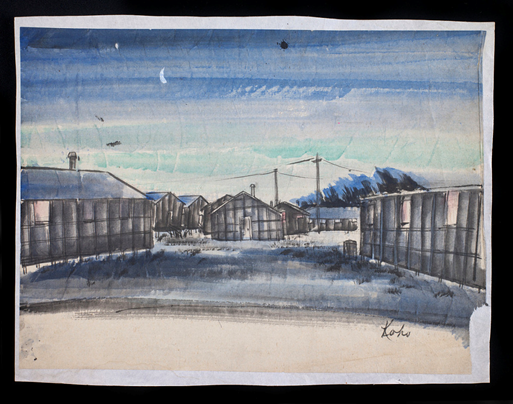The Beginning of Internment
The attack on Pearl Harbor on December 7th, 1941, shocked and angered Americans. The attack exacerbated longstanding anti-Asian racism, and many came to view all citizens of Japanese descent, including both issei (foreign-born) and nisei (born in the US), with suspicion as potential “threats to national security” and spies. Consequently, in 1942, President Franklin Roosevelt divided the entire West Coast into military zones and signed Executive Order 9066, which authorized military commanders to exclude “any or all persons” from these military zones.
Despite its broad language, the order was clearly directed towards the Japanese population: Lieutenant General John L. DeWitt first announced curfews only for Japanese Americans, then allowed voluntary evacuation, and on March 29th, 1942, he issued Public Proclamation No. 4, which forced Japanese citizens on the West Coast to leave their homes with only a 48-hour notice. The evicted citizens, many of whom were unable to make arrangements to secure their property, lost almost all of their belongings. There was no appeal process for the detainees.
“We want to keep this a white man’s country.”
“All Japanese [should] be put in concentration camps for the remainder of the war.”
- Bert Miller, Attorney General of Idaho
“I am determined that if they have one drop of Japanese blood in them, they must go to camp.”
- Colonel Karl Bendetsen, key architect in Japanese internment
Life in the Camps
122,200 citizens were first moved to assembly centers, then internment camps located in remote inland areas. These assembly centers were converted fairgrounds, racetracks, or other facilities with often inhospitable conditions – some citizens lived in horse stalls during their stay. Of these 122,200 citizens, 70,000 were American citizens; no Japanese citizen was ever found to be a spy or to be treasonous against the US.
In the camps, families were housed together in military-style barracks with little insulation against the heat and cold. The camps were located in some of the remotest areas of the US, in barren environments that became livable as the detainees brought in water. In spite of their conditions, those detained in the camps set up schools, newspapers, markets, etc. They played baseball and held community events to give some semblance of a regular life. However, the barbed wire and guard towers surrounding the camps constantly served as a stark reminder of their conditions.
Adults living in the camps were asked to fill out what became known as a “loyalty questionnaire.” Detainees answered questions about their background, religion, language proficiency, etc., with their responses being judged for how “American” they were. Most controversially, question 27 asked if the detainees would serve in the US war effort when called upon – Nisei men were asked if they were willing to serve on combat duty – and question 28 asked if they would swear allegiance to the US and renounce their loyalty to Japan. Japanese citizens were barred from US citizenship due to their race, so renouncing Japanese citizenship would have essentially rendered them stateless. Additionally, many citizens had never held any allegiance to the Japanese emperor, so they resented the question about pledging loyalty to the United States.
Those who answered “No” to both questions 27 and 28 became known as the “no-no boys” and were labeled as disloyal and sent to a separate camp within Tule Lake for “dissidents.” Even though reasons for their responses varied, no-no boys, following the war, continued to face backlash for being “cowardly” and “disloyal,” especially by Japanese Americans who blamed them for giving off the impression that the Japanese were disloyal to the US.
Opposition, Service, and the End of Internment
The policy of internment did not go through without opposition: figures in the Roosevelt administration like Attorney General Francis Biddle opposed internment, and citizens challenged internment in court. In 1944, Fred Korematsu refused to leave the exclusion zone, challenging the general exclusion of Japanese citizens from the West Coast in the Supreme Court case Korematsu v. United States. In an infamous ruling, the Court upheld the constitutionality of exclusion and internment in a 6-3 decision.
Ironically, in spite of the widespread distrust of the Japanese population, regiments of American soldiers of Japanese descent fought bravely for the Americans during World War II. 33,000 served in the military, with 20,000 of those soldiers being in the Army. One such regiment, the 442nd Infantry Regiment that served in campaigns in Italy, is the most decorated unit in US military history. The 442nd Regiment, with its motto “Go for Broke,” was renowned for its excellence in maneuvering and bravery. Out of 18,000 who served, 4,000 received Purple Hearts, with the 100th Battalion being nicknamed the “Purple Heart Battalion” for the heavy casualties it suffered. Additionally, 21 members of the regiment received the Medal of Honor.
At the same time as the Korematsu ruling in 1944, the Supreme Court ruled in Ex parte Endo that the detainment of loyal US citizens was unconstitutional, opening the way for Japanese citizens to be released. As Roosevelt was notified of the court ruling, the Western Defense Command issued Public Proclamation No. 21 on December 17th, 1944, rescinding the exclusion orders, and allowing Japanese citizens to return to the West Coast. Those incarcerated in the internment camps were free to go, but they had lost almost everything. Tule Lake, used to hold “disloyal” citizens or dissidents, closed in 1946.
In the 1980s, the Reagan administration passed the Civil Liberties Act of 1988, granting $20,000 to each surviving detainee. The reparations were not comprehensive in compensating all those who had suffered from internment: those who had passed away during the four decades since they had been imprisoned at the camps were ineligible. Additionally, those who left the exclusion zone voluntarily and those who weren’t detained because of their military service were not compensated. However, the act still represented a formal apology from the US government for Japanese internment and an acknowledgement of its wrongdoing. The act stated that it sought to “discourage the occurrence of similar injustices and violations of civil liberties in the future and make more credible and sincere any declaration of concern by the United States over violations of human rights committed by other nations.”
List of Internment Camps:
- Tule Lake (CA)
- Manzanar (CA)
- Poston (AZ)
- Gila River (AZ)
- Minidoka (ID)
- Topaz (UT)
- Heart Mountain (WY)
- Granada (CO)
- Jerome (AR)
- Rohwer (AR)
 Essay by Austin Guo, Princeton Class of 2026. Austin spent the summer as an intern at the Jay Heritage Center through the Princeton Internship for Civic Service (PICS). He helped strategize ways to make the history of the landmark Jay Estate more visually accessible to a broader range of visitors. He also researched models for bringing art installations and competitions to the site.
Essay by Austin Guo, Princeton Class of 2026. Austin spent the summer as an intern at the Jay Heritage Center through the Princeton Internship for Civic Service (PICS). He helped strategize ways to make the history of the landmark Jay Estate more visually accessible to a broader range of visitors. He also researched models for bringing art installations and competitions to the site.
